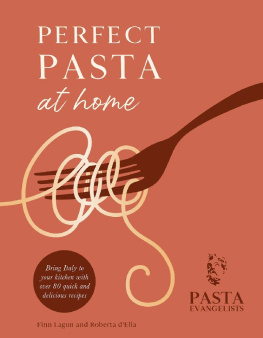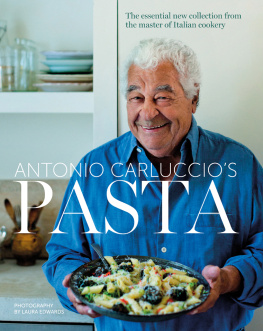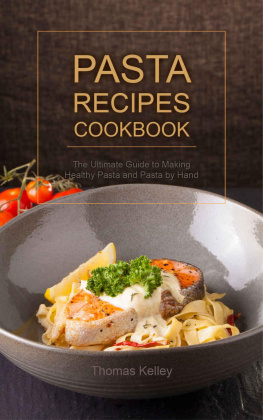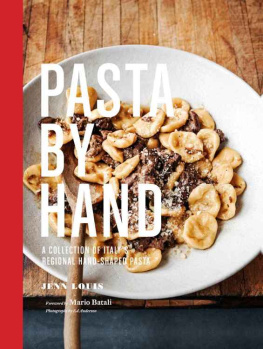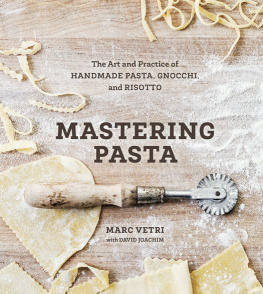
To everyone who cares about everything and who knows that the little things are what matter most.
Copyright 2015 by Jenn Louis.
All rights reserved. No part of this book may be reproduced in any form without written permission from the publisher.
Library of Congress Cataloging-in-Publication Data available.
ISBN 978-1-4521-2188-8 (hc)
ISBN 978-1-4521-3057-6 (epub2, mobi)
Designed by Alice Chau
Photographs by Ed Anderson
Food styling by George Dolese
The photographer wishes to thank Jenn Louis and David Welch for their hospitality, generosity, and great on-set breakfasts; George Dolese for his light-handed sense of style that makes every shot sing; and the friendly city of Portland, Oregon.
Chronicle Books LLC
680 Second Street
San Francisco, California 94107
www.chroniclebooks.com
ACKNOWLEDGMENTS
Thank you to all of the Italians and Italian Americans who generously shared their culture with me.
Thank you to everyone who has believed in me, supported me, and been patient with me.
Andrew Sessa, Kathleen Squires, Ed Anderson, and George Dolese, thank you for taking a great interest in a project so important to me.
Zaffy and Denis, thank you for sharing so much love with me and teaching me the importance of community.
Thank you to my pop, Jeff. I am so grateful for our relationship. I love you. And thank you to my brother, David, and my sister, Stacy.
Thank you to my wonderfully lovely husband, David. Thank you for always being at my side. I love you more than anything.
In loving memory of my mother, Isabel. I will bake your challah recipe as many Fridays as I can.
I have this joke about Italians: When you have ten Italians in a room, you have fourteen opinions.
FOREWORD
The chef world is growing more and more crowded every day. On just about every cable and network TV channel, there are chef competition shows featuring lesser-known chefs vying for fame, fortune, and their own 15 minutes, who are judged by other chefs who have moved up the reality-program ranks and are venerated, at least for the moment, as king and queen chefs. There are iron chefs, top chefs, kid chefs, master chefs, biker chefs, rock-and-roll chefs, late-night chefs, and daytime network chefs. In the summer of 2014, there were three full-length feature films in national release about chefs with the word chef in the title. Chefs are media hot.
It seems to me that these TV/media chefs are so busy that there is very little time between the hours spent in the makeup room, in media training, with stage hands, with prop stylists, and with camera crews to actually cook. What is becoming rarer is the chef who spends time researching and devising true and self-fulfilling deliciousness. Balancing the very important role of promotion and the even more important role of creating tasty and thoughtful food on a daily basis is tough business. When I scan a city for a visit, I am most happy when I find a chef who values his or her own craft over making morning show appearances. That is not to say that I do not love dining at restaurants run by chefs who have serious media presence, such as Emeril Lagasse, Bobby Flay, Michael Symon, and Wolfgang Puck. But every now and then I find or meet a chef who is so thoughtful and passionate about cooking that Im inspired to get to the market, feel renewed excitement at the stove, and am reminded about the true joy of food.
Jenn Louis is such a chef.
Jenns enthusiasm about food, cooking, and life is exciting. It is written into every email or text message she has ever sent me. It is epidemic. And her passion is both thrilling and disruptive. In her relentless search for the authentic, the real, the traditional, and the not-so-obvious, she has traveled to nearly all of the magnificent and unique regions in the boot of Italy looking for the comprehensive truth and all-encompassing enlightenment about... dumplings? Oh yes she has.
One of the main objectives of the Slow Food movement is to define and maintain rich regional traditions, ingredients, techniques, and products as a defense against the commercialization and homogenization and the subsequent or eventual loss of these cornerstones of excellence. The handmade Italian dumpling is indeed an exquisite example of a food well worth our Slow attention. Eschewing dried pasta, stuffed pasta, baked pasta, pasta asciutta, and all other forms of the glorious category called primi in Italian, Jenn has spent countless hours of research and travel pursuing the humble and magnificent category of dumpling, what Italians call gnocchi. And we the readers can say beati noi, which loosely translates from Italian to lucky (or more precisely, blessed) us.
Jenn has uncovered and brought to light such delicious (I only surmise) and traditional dishes as frascarelli, dunderi, and ciciones. As intuitive as these dumplings seem to me now that I see them on Jenns pages, their existence and the fact that I have never tasted them, let alone heard of them, cause me to question the depth of my own commitment to Italian regional cooking. But I am not dismayed. No, I am excited. My work is rejuvenated by the new, for me, wrinkle in the complex and infinite delights of Italian gastronomy.
In all of my years traveling similar roads doing similar-minded research to Jenns, I have never encountered such a magnificent single-topic cookbook as Pasta by Hand. This spectacular volume is poetically inspirational and defines the work of the chef in the twenty-first century well beyond the world of broadcast and Internet programming. But for me, Pasta by Hand will be a marker, a moment in time, from which I will forever measure a renewal of my passion as a chef. It has given new breath to my lifes project and my search for delicious and authentic foods that are expressions of joy and love in a pot or on a plate. And for that I thank you, Chef Louis.
MARIO BATALI
INTRODUCTION
I was backpacking in Europe when I first ate authentic Italian gnocchi. It was twenty years ago, and I had just graduated from college. Throughout the trip, I mostly ate bread, cheese, or whatever I could afford, keeping a few staples in my daypack to sustain myself. It was not extravagant fare. One dark December evening, I found myself in a restaurant in Siena, Tuscany. It was an ancient structure, tucked into a catacomb of winding cobblestone walkways. It was 6 P.M., and though I was the only one dining that early, the restaurant was open and I was hungry. I splurged on potato gnocchi with basil pesto, and I was in love after just one bite.
When we were preparing to open Lincoln Restaurant in 2008, I considered using dried pasta, but after we opened serving fresh, handmade pasta, I knew we could never do anything less. I wanted our guests to have a special experience eating fresh pasta, as I had with those first gnocchi in Siena. Fresh pasta was a part of our commitment to our customers: everything we serve would be made by hand. We would always carefully consider which pastas we would make and which sauces we would pair with them. We started with cavatelli (ricotta and semolina), pappardelle, and fettuccine, and then we began to research more interesting regional pastas. We made lasagnette (with white wine), malloreddus (with saffron from Sardinia), and tajarin (angel-hair pasta from Piedmont). We varied the offering based on the season.
As I learned more about the different classes of pasta, I became inspired by Italian dumplings. Like most Americans, the only Italian dumplings I had known of were tender potato gnocchi. But once I started to make different varieties of dumplings at Lincoln, such as sorcetti and malloreddus, they became a standard on the menu. I couldnt stop researching the subject, and I made it a rule that we always would offer at least one variety of gnocchi. (The subject of what a dumpling is is somewhat complicated. Ill explain later; read on.)
Next page






![Missy Robbins - Pasta : The Spirit and Craft of Italys Greatest Food, with Recipes [A Cookbook]](/uploads/posts/book/300525/thumbs/missy-robbins-pasta-the-spirit-and-craft-of.jpg)

